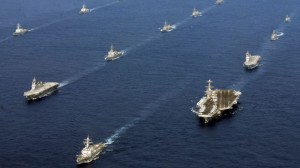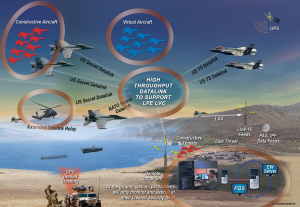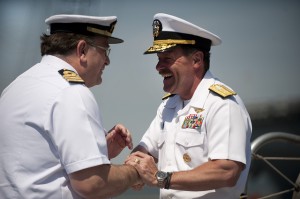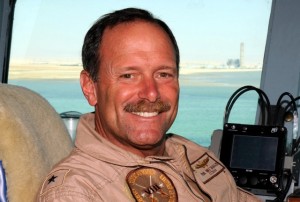2014-11-14 By Robbin Laird and Ed Timperlake
After our visit to the Naval Strike and Air Warfare Center at Fallon Naval Air Station where we focused on the training for the current and evolving integrated strike group, we had a chance to discuss our experience with Rear Admiral Michael Manazir, Director of Naval Air Warfare.
The conversation revolved around the impact of fifth generation capabilities on the evolution of the integrated strike group, to include the impact of the new carrier, the USS Ford, and the overall extended capabilities of the evolving sea base, both amphibious assault and carrier strike.
And in a recent interview, which our colleague Gordon Chang conducted earlier this year with the Admiral, the approach which the Admiral is pursuing with regard to the joint and coalition approach to the evolving strike force was evident.
“In the tense settings of the future, the partnerships with allied navies will be force multipliers, taking the strain off America’s shrinking defense budgets.”
In the interview Rear Admiral Manazir drew upon his recent carrier command experience to highlight the role of global partnerships in shaping deterrence in depth capabilities.
Rear Admiral Michael Manazir made this point when he told me how in May of last year he stared down Iranian craft that wanted to interfere with the ships he commanded in international water in the Persian Gulf.
Yes, his vessels must have looked impressive to the Iranians, but what was even more fearsome was the multinational task force of which they were a part.
Manazir’s ships were but a few of the 35 vessels participating in the International Mine Countermeasures Exercise, a freedom of navigation drill that last year included 6,500 sailors and representatives from 41 nations.
There is nothing so frightening for the seamen of a rogue state than to see ships from a unified coalition on the high seas backed by history’s mightiest maritime force.
Question: During our visit to Fallon, it was clear that the key focus of Naval aviation tactics and training is strike integration to successfully fight with the fleet you have, but at all command levels there was also a very clear understanding of always anticipating the future. You are in charge of looking at that future and how do you view that in relation to the current strike integration focus?

Rear Admiral Manazir: Fallon is organized for integrated air wing training. They are not focused on whether an airplane is an F (fighter), A (attack) or an E (electronic warfare); they are focused on how does this air wing come together and fight with an F component, an E component and an A component.
The fifth generation is bringing us the opportunity and indeed the imperative to fundamentally alter the way we look at air warfare. The F-35 is not an A or an E or an F; it is all of those.
Earlier we had an F-14, an A-6 and an EA-6B and needed all three to do our job; now one airplane blends those capabilities and we can leverage that as we look at the integration of the other capabilities of the air wing we are developing.
Fifth generation is opening up so many possibilities that how we used to think about our capabilities is changing; how do we wring out the full capabilities of the air wing with the fifth generation as a catalyst for change?
Question: A clear lesson learned from Fallon is the need to alter the training approach to deal with 21st century threats as well as capabilities. To do so, they are focused on Live, Virtual and Constructive (LVC) training. How do you view this in regard to shaping the airwing of the future?
Rear Admiral Manazir: The initial operational capability of fifth generation fundamentally changes the way that we’re going to fight.
Where it used to be platform-to-platform, we now have inherent in a single weapon system, the capability to fold in all those things that we used to think were single missions, like the fighter mission, like the attack mission, like the electronic warfare mission.
Those missions were given to separate platforms because we didn’t have the way to fold them into a single platform. Now we have that capability to do that. So that fundamentally causes us to look at the way in which we do business in the future.
When we train, we always train to an integrated capability. At Fallon, we assume that the air wing squadrons are already trained to their individual skill sets, they’re already to a level at which they’re ready for integrated training against a very, very high-end mission set.
That mission set is modelled against an updated threat presentation that we corroborate across all intelligence sources to understand the threat we’re going to go against. And then we build training scenarios to that point at all security levels.
The current air wing that we have is capable of training inside the Fallon battlespace in a way in which we normally train: you use simulators to practice, and then you get in your airplane and you go against representative threat systems. Most of the representative legacy threat systems are on the Fallon ranges. And they are either physically there or we have a simulation that emulates the threat presentation. And all of that can be contained in that air space.
The threat baseline that we’re looking to fight in the mid-2020s and beyond is so much more advanced that we cannot replicate it using live assets. And those advances are in the aircraft capability, the weapon capability, and in the electronic warfare capability of the threat systems. That drives us to thinking about a different way to train.
In order to do that, you have to be able to have a realistic and representative emulation of the threat that is not live. And there are a couple of ways to do that. The first one is you make it completely constructive, and the second way is you make it simulated.

Live, virtual, constructive (LVC) training is a way to put together a representation of the threat baseline where you can train to the very high end using your fifth generation capability. Some of it is live with a kid in the cockpit, some of it is virtual in a simulator, and so “virtual” is actually the simulator environment. And then constructive is a way to use computers to generate a scenario displayed on either or both of the live or simulated cockpit.
You can also combine them to be live-constructive, or virtual-constructive, and by that I mean there are systems out there right now that you can install in the airplane that will give you a constructive radar picture air-to-air and surface-to-air along with the electronics effects right onto your scope.
You’re literally flying your airplane, and through a data link, you can share that information between airplanes, you can share it between dissimilar airplanes.
You could take a set of Navy airplanes, for instance, an E2D and a division of F-18s or F-35s on the Fallon range. And you could have a constructive scenario that is piped into all five of those airplanes. It’s the same scenario, has all the same effects. And then the blue players can act according to that constructive scenario, and react to that constructive scenario in the live environment, but there’s nothing real in front of them…the threat is all simulated by computer generation.
Now let’s say that through fiber network, you pipe that constructive picture over to a coalition partner…for example, you do so to the RAAF in Australia…it is piped to a live airplane or a simulator over there, and let’s say there’s two Australian airplane simulators, and they’re seeing the same picture as the Americans are fighting.
And let’s say that there is a network that goes to the Aegis Cruiser, which is off the coast of Florida, and is going to be their Aegis Cruiser for the training. And you can show them the same picture.
And you can transmit the comms across that. You can easily see the training power in this LVC construct.
There are other systems that will allow you to have a live wingman up in the air in Fallon or on another range, his lead in a simulator, and when the simulator lead looks at his or her visual, he can see a virtual representation of his live wingman doing everything he does in the aircraft , and a link sends the aircraft maneuvers down to the simulator.
And when the simulator or the live person looks through their enhanced Joint Helmet Mounted Queuing System, he can see a virtual airplane on his visor.
When the virtual airplane on the helmet system say, dumps a flare or drops ordnance against the target, you actually see it come off the airplane in your visor. And you can actually fight a virtual bogey on your visor, and the guy’s not there. And you fight it with your airplane, just as if it is a real piece of metal. So that’s the live-constructive piece.
If you optimize the networks so that you have a live airplane flying somewhere, a simulator that’s exactly what emulates a live airplane, and then a constructive scenario that goes to both you now have the full LVC construct. You can overcome the barriers of geography, if the range is not big enough. You could also overcome the barriers of multilevel security, because if you go up and use all of your weapons system modes up in the air, live, there are surveillance systems that can pick up what you’re doing.

In this way, you can protect high end modes with encryption, and then create an architecture where LVC allows you to train to the complete capability of your fifth generation platform integrated into the advanced air wing and connected to AEGIS and the aircraft carrier as well as operations centers ashore. And that’s what we’re looking to do.
We realize that the fifth generation platform has now bumped us up against the limits of our training ranges and that we do not quite have the LVC components built yet, so that is where our current focus lies.
Question: In this approach, clearly you are looking at the “red” side, but the “blue” side is equally demanding.
With fifth generation, you are looking at off-boarding capabilities such as the fifth generation acting as forward deployed scouts identifying targets for Navy weapons.
How do you view this aspect of the challenge?
Rear Admiral Manazir: I could absolutely finish your sentence.
It is as challenging right now to figure out how to use this fifth generation capability as to deal with the “red” side.
We’re thinking about integrating the weapons system capability…not the platform…in reshaping the airwing – that is the challenge.
In the past, any high-end capability, like the F-117 in Desert Storm, went by itself. The approach was: leave me alone, don’t touch me; I can operate more effectively alone. From this perspective, fifth generation is understood as a high end, leave alone capability: the capability to go downtown with a low probability of intercept, low probability of detection data link and associated weapons systems that allows the platform to operate inside the red battlespace.
We are not simply doing that.
We are focused on the ability to connect into the integrated fire control network, pull that fifth generation information into the network.
We’re learning a lot of lessons from F-22, we’re bringing those lessons on as our corporate knowledge starts to gell so we understand how to do this effectively.
You captured the exact point.
We think of integrated capability.
If you take this fifth generation airplane that people like to keep by itself, how do you integrate into the strike group? But integration from the blue side is the key challenge and advantage of adding fifth generation to the airwing.
Question: Another aspect of thinking about the F-35 is the impact of a global fleet of F-35s.
With your ability to operate integrated with your F-35Cs with joint or coalition aircraft, the reach of the carrier air wing is extended significantly.
Rear Admiral Manazir: Reach not range is a key aspect of looking at the carrier airwing and its ability to work with joint and coalition forces. This is clearly enhanced with the F-35.
What you can do with a Carrier, given joint and coalition perspectives is the Carrier automatically extends your reach because you can put it anywhere you want. The mobility of the carrier is a key point. You can put it up against the problem set the national command authority or the joint force commander wishes to address; and then you can move it to deal with an evolving target or operational set of challenges, again aligned with the commander’s intent.

You can move the reach of the carrier wing as you redeploy it and connect with joint or coalition assets. The carrier has a core ability to operate organically but its real impact comes from its synergy with the joint and coalition force, which will only go up as the global F-35 fleet emerges.
And this will get better with the coming of the USS Ford. What the Ford does is it optimizes the things that we think are the most important.
Some of those capabilities are clear:
- Enhanced sortie generation capabilities or the number of times you can get airplanes into the mix to keep the reach out there
- The power generation capability, so advanced systems can operate off of the ship.
- The ability to take the information that is brought back through the airborne network into the ship and be able to disseminate it to decision makers is enhanced over the Nimitz class.
Question: Another key way to consider the carrier, its airwing and the evolution of concepts of operations is to rethink the role of the sea base.
It is not just about the USS Ford; it is about the USS America, the USS Arlington, the T-AKE ships, the amphibious assault task force and the evolving carrier air wing as a whole.
The capability to link US maritime and air assets as well as those of coalition forces creates a whole new set of possibilities.
What is your take on this dynamic?
Rear Admiral Manazir: I am the son of a Marine. What you are talking about is in my blood. And the Marines are leading the charge on fifth generation capability and bringing it into the fleet.
And when we think back to World War II, the Navy-Marine team in the Pacific was the integration of core capabilities, which defeated the Japanese forces. The new ships, the coming of the F-35 and reworking our concepts of operations enhance such integration.
And a key element is the capability to evolve our systems over time. It needs to be recognized that the USN shares its investment in F-35 combat systems with the USMC, the USAF and coalition partners – we are all using the same combat systems in our aircraft. That is an investment multiplier.
As the F-35 and its fifth generation data fusion capabilities continue to advance through the follow-on development of the software, processing that information that we’re going to be able to get from the environment through the fifth generation systems into the Carrier, and then to be able to input that information into a decision loop, and then acting will be a big step forward.
Question: And the flexibility of your evolving carrier air wing to support the kind of 21st century strategic environment is crucial as well.
The carrier air wing can lead an effort, support a joint effort, or lead or support a coalition effort.
The President spoke of leading from behind, but I would prefer supporting a coalition partner, but one can envisage new possibilities.
For example, the Aussies are leading an effort in their part of the woods and have made their new Canberra-class amphibious ships a flagship of their operation.
They fly their potential F-35Bs off of those ships.
The planes connect directly to your carrier F-35s and then your carrier Admiral can provide significant real time support to that Australian effort up to the level desired by the US National command authority.
The capabilities of the USS Ford to support such a decision effort are a significant step forward as well.
Rear Admiral Manazir: They are.
But to get full value from the scenario you described the training piece is crucial. Exercises and training will be essential to shape the kind of convergent capability, which the new systems will allow. Training unlocks those kinds of options. It is not just about technology.
And as we re-shape our concepts of operations under the influence of fifth generation capabilities, we need to re-focus our investments on the missing pieces revealed by re-shaping our concepts of operations.
As we think about the threat baseline, as we think about the potential scenarios that we could be in, and as we think about our operational plans, and about our campaign analyses, we will look at our evolving integrated capability, and then figure out where our gaps are.
My job is to buy those capabilities. I need to be able to look at the entire spectrum of the operational level of war, and determine where I invest.
I’m able to balance my investments, taking advantage of fifth generation capability.
I’m thinking about what is my potential with investment, to enhance my capability.
And when I am focused on the evolving impact of integration I am thinking of both the F-35 and the USS Ford and what these two platforms together bring to wring out the capabilities of legacy assets and to shape a way ahead for new ones. It is about the impact of the carrier and its airwing on the role of the seabase within the joint and coalition environment.
The photos in the slideshow above provide various shots of operations aboard the USS Nimitz in early November 2014.
The photos are credited to Naval Media Services.
A condensed version of this interview has appeared initially on Breaking Defense:
http://breakingdefense.com/2014/11/expanding-the-reach-of-the-carrier-strike-group/
For a Special Report with all the Fallon interviews along with interviews with the past and current heads of Air Warfare for the USN see the following:
The Future of Naval Aviation Special Report
As PDF version:
https://sldinfo.com/the-evolving-future-for-naval-aviation/
As an E-book:
https://sldinfo.com/flipbooks/Distributed%20Laydown/TheFutureofNavalAviationNovember2014/

